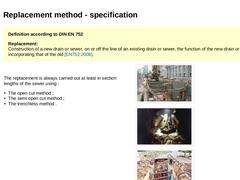
|

Definition according to DIN EN 752 Replacement:
Construction of a new drain or sewer, on or off the line of an existing drain or sewer, the function of the new drain or sewer incorporating that of the old [EN752:2008]. | |
The replacement is always carried out at least in section lengths of the sewer using : - The open cut method ;
- The semi open cut method ;
- The trenchless method .
| |
(Image: Replacement of sewers using the open cut method)
|
|
(Image: Replacement … |
|
|
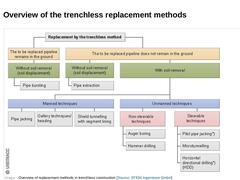
|

| (Image: Overview of replacement methods in trenchless construction)
|
|
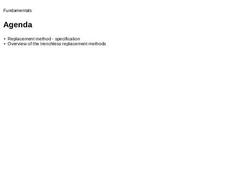
|

|
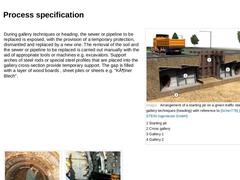
|

| (Image: Arrangement of a starting pit on a green traffic island using gallery techniques (heading) with reference to [Scher77b] [Image: S&P GmbH]) During gallery techniques or heading, the sewer or pipeline to be replaced is exposed, with the provision of a temporary protection, dismantled and replaced by a new one. The removal of the soil and the sewer or pipeline to be replaced is carried out manually with the aid of appropriate tools or machines … |
|

|

|
The gallery techniques or heading requires the application of the following material, equipment and plants: - support arches
- shuttering
- wood shuttering
- steel shuttering
- machines for hammering in shutterings
- machines for the removal and transport of soil
- ventilation devices
|
(Image: Support arches (special steel profile) to protect the gallery)
|
(Image: Steel shuttering)
|
(Image: Converted mini-excavator with conveyor belt)
|
(Image: Diffuser fan … |
|
|

|

|
The construction consists of the following: - heading of the gallery and exposing of the sewer or pipeline to be replaced
- replacement of pipeline by prefabricated pipes or by in-cast concrete
- filling of annular space
| |
(Image: Working steps of gallery techniques (heading) - Exposion of the sewer or pipeline to be replaced)
|
(Image: Working steps of gallery techniques (heading) - Installation of the new sewer or pipeline)
|
(Image: Working steps of … |
|
|
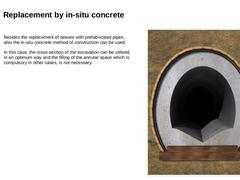
|

|
Besides the replacement of sewers with prefabricated pipes, also the in-situ concrete method of construction can be used. In this case, the cross-section of the excavation can be utilised in an optimum way and the filling of the annular space which is compulsory in other cases, is not necessary. | (Image: Possibilities of interior work using gallery techniques (heading) with reference to [Düsse] [Image: S&P GmbH])
|
|
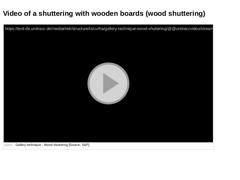
|

(Video: Gallery technique - Wood shuttering) |
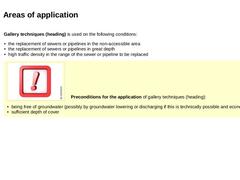
|

| Gallery techniques (heading) is used on the following conditions: - the replacement of sewers or pipelines in the non-accessible area
- the replacement of sewers or pipelines in great depth
- high traffic density in the range of the sewer or pipeline to be replaced
| | (Image: Attention!) Preconditions for the application of gallery techniques (heading): - being free of groundwater (possibly by groundwater lowering or discharging if this is technically possible …
|
|
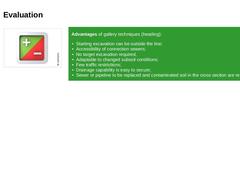
|

| (Image: Pros and cons) | Advantages of gallery techniques (heading): - Starting excavation can be outside the line;
- Accessibility of connection sewers;
- No target excavation required,
- Adaptable to changed subsoil conditions;
- Few traffic restrictions;
- Drainage capability is easy to secure;
- Sewer or pipeline to be replaced and contaminated soil in the cross section are removed.
|
|
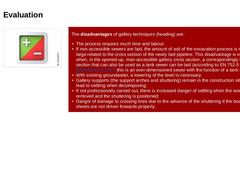
|

| (Image: Pros and cons) | The disadvantages of gallery techniques (heading) are: - The process requires much time and labour;
- If non-accessible sewers are laid, the amount of soil of the excavation process is relatively large related to the cross section of the newly laid pipeline. This disadvantage is eliminated when, in the opened-up, man-accessible gallery cross section, a correspondingly larger cross-section that can also be used as a tank sewer …
|
|
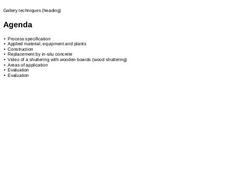
|

|
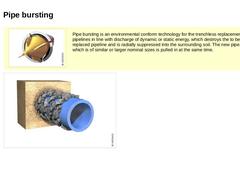
|

| (Image: Replacement by trenchless method)
Pipe bursting is an environmental conform technology for the trenchless replacement of pipelines in line with discharge of dynamic or static energy, which destroys the to be replaced pipeline and is radially suppressed into the surrounding soil. The new pipe, which is of similar or larger nominal sizes is pulled in at the same time. | | (Image: Replacement)
|
|
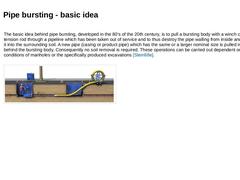
|

|
The basic idea behind pipe bursting, developed in the 80's of the 20th century, is to pull a bursting body with a winch cable or a tension rod through a pipeline which has been taken out of service and to thus destroy the pipe walling from inside and to force it into the surrounding soil. A new pipe (casing or product pipe) which has the same or a larger nominal size is pulled in directly behind the bursting body. Consequently no soil removal is … |
|
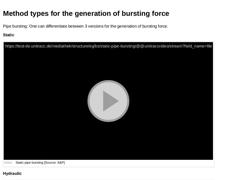
|

Pipe bursting: One can differentiate between 3 versions for the generation of bursting force. Static (Video: Static pipe bursting) Hydraulic (Video: Hydraulic pipe bursting) Pneumatic (Video: Pneumatic pipe bursting) |
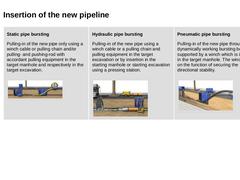
|

Insertion of the new pipeline (Folientitel vorher: Method types of pipe bursting) |
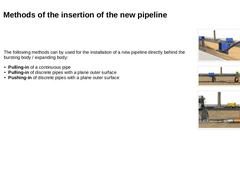
|

|
The following methods can by used for the installation of a new pipeline directly behind the bursting body / expanding body: - Pulling-in of a continuous pipe
- Pulling-in of discrete pipes with a plane outer surface
- Pushing-in of discrete pipes with a plane outer surface
| |
(Image: Illustration of the pneumatic pipe bursting - pulling-in of a continuous pipe)
|
|
(Image: Pneumatic pipe bursting process - pulling-in of discrete pipes)
|
|
(Image: Hydraulic … |
|
|
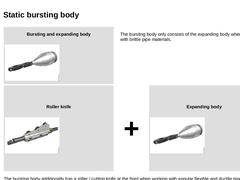
|

Bursting and expanding body (Image: Bursting and expanding body for static pipe bursting)
|
The bursting body only consists of the expanding body when working with brittle pipe materials. | | Roller knife (Image: Roller knife for static pipe bursting)
| + | Expanding body (Image: Bursting and expanding body for static pipe bursting)
| |
The bursting body additionally has a roller / cutting knife at the front when working with angular flexible and ductile pipe materials. |
|
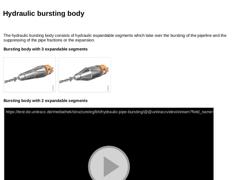
|

The hydraulic bursting body consists of hydraulic expandable segments which take over the bursting of the pipeline and the suppressing of the pipe fractions or the expansion. Bursting body with 3 expandable segments (Image: Hydraulic pipe bursting - Bursting head with 3 expandable segments (closed)) (Image: Hydraulic pipe bursting - Bursting head with 3 expandable segments (opened)) Bursting body with 2 expandable segments (Video: Hydraulic pipe bursting) |
|
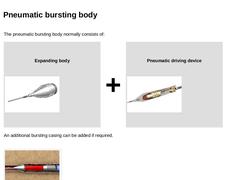
|

| The pneumatic bursting body normally consists of: | Expanding body (Image: Expanding head for pneumatic pipe bursting) | + | Pneumatic driving device (Image: Pneumatic bursting unit) | | An additional bursting casing can be added if required. (Image: Pneumatic pipe bursting unit with an auxiliary bursting cap and expander head in the rear; replacement with a HDPE continuous pipe from the insertion pit to the reception pit) |
|
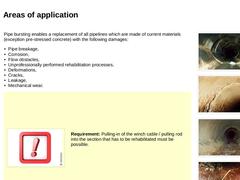
|

|
Pipe bursting enables a replacement of all pipelines which are made of current materials (exception pre-stressed concrete) with the following damages: - Pipe breakage,
- Corrosion,
- Flow obstacles,
- Unprofessionally performed rehabilitation processes,
- Deformations,
- Cracks,
- Leakage,
- Mechanical wear.
| |
(Image: Collapse [FI-Jtele])
|
|
(Image: Lateral crack [FI-Jtele])
|
|
(Image: Corrosion in the invert area and longitudinal crack [FI-Jtele])
|
|
(Image: Longitudinal … |
|
|
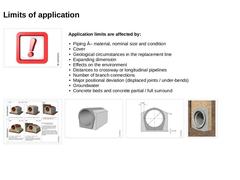
|

| (Image: Attention!)
|
Application limits are affected by: - Piping – material, nominal size and condition
- Cover
- Geological circumstances in the replacement line
- Expanding dimension
- Effects on the environment
- Distances to crossway or longitudinal pipelines
- Number of branch connections
- Major positional deviation (displaced joints / under-bends)
- Groundwater
- Concrete beds and concrete partial / full surround
| |
(Image: Encasement and special supports of … |
|
|
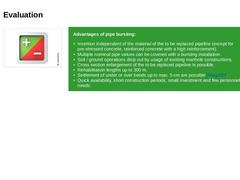
|

| (Image: Pros and cons) | Advantages of pipe bursting: - Insertion independent of the material of the to be replaced pipeline (except for pre-stressed concrete, reinforced concrete with a high reinforcement).
- Multiple nominal pipe values can be covered with a bursting installation.
- Soil / ground operations drop out by usage of existing manhole constructions.
- Cross section enlargement of the to be replaced pipeline is possible.
- Rehabilitation lengths …
|
|
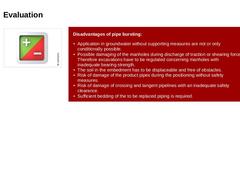
|

| (Image: Pros and cons) | Disadvantages of pipe bursting: - Application in groundwater without supporting measures are not or only conditionally possible.
- Possible damaging of the manholes during discharge of traction or shearing force. Therefore excavations have to be regulated concerning manholes with inadequate bearing strength.
- The soil in the embedment has to be displaceable and free of obstacles.
- Risk of damage of the product pipes during the positioning …
|
|
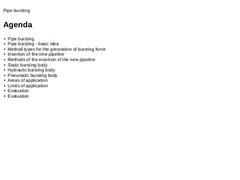
|

|